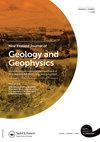新西兰凯库拉半岛2016年凯库拉地震和晚第四纪期间的隆起和断层滑动
IF 1.9
4区 地球科学
Q1 GEOLOGY
New Zealand Journal of Geology and Geophysics
Pub Date : 2022-02-02
DOI:10.1080/00288306.2021.2021955
引用次数: 11
摘要
Kaikōura地震使Kaikōura半岛隆起≤1 m。2016年的隆升主要是由一条海上逆冲断层(OSTF)的滑动引起的,该断层被模拟为从板块界面向外伸展,并进一步受到两条新发现断层(阿默斯海滩断层,ABF;差分激光雷达(D-lidar)绘制了Taumanu断层(TTF)。正向位错模拟表明,2016年的半岛隆升可以通过OSTF上的平均滑动~ 2.3 m, ABF和TTF上的平均滑动0.25 ~ 0.5 m来再现。2016年地震记录的同震隆起与MIS5c(96±5 ka)和MIS5e(123±5 ka)海相台地的近均匀(1.2±0.2°)西北倾斜不同;这些年龄受到光激发发光(OSL)测年和与海平面曲线的相关性的限制。晚第四纪海相阶地的倾斜主要可以通过OSTF上的~ 0.8 ~ 2.7 mm/yr和ABF上的0.3 ~ 0.6 mm/yr的滑动速率来重现。TTF的滑动不需要产生海相阶地的倾斜,这表明它在晚第四纪的破裂频率可能低于OSTF和ABF。OSTF将2016年Kaikōura北部和南部的断裂联系起来,地震破坏了一个相互连接的断层网络。本文章由计算机程序翻译,如有差异,请以英文原文为准。
Uplift and fault slip during the 2016 Kaikōura Earthquake and Late Quaternary, Kaikōura Peninsula, New Zealand
ABSTRACT The Kaikōura Earthquake uplifted Kaikōura Peninsula by ≤∼1 m. Uplift in 2016 mainly resulted from slip on an offshore thrust fault (OSTF), modelled to splay from the plate-interface, and was further influenced by slip on two newly identified faults (Armers Beach Fault, ABF; Te Taumanu Fault, TTF) mapped onshore from differential lidar (D-lidar). Forward dislocation modelling indicates that 2016 peninsula uplift can be reproduced by mean slip of ∼2.3 m on the OSTF and 0.25–0.5 m on the ABF and TTF. The variable co-seismic uplift recorded during the 2016 earthquake differs from the near-uniform (1.2 ± 0.2°) northwest tilting of MIS5c (96 ± 5 ka) and MIS5e (123 ± 5 ka) marine terraces; these ages are constrained by Optically Stimulated Luminescence (OSL) dating and correlation to sea-level curves. Tilting of Late Quaternary marine terraces can be primarily reproduced by slip rates of ∼0.8–2.7 mm/yr on the OSTF and 0.3–0.6 mm/yr on the ABF. Slip on the TTF is not required to produce tilting of the marine terraces, suggesting that it may have ruptured less frequently than the OSTF and ABF in the Late Quaternary. The OSTF links 2016 ruptures north and south of Kaikōura, with the earthquake rupturing an interconnected network of faults.
求助全文
通过发布文献求助,成功后即可免费获取论文全文。
去求助
来源期刊
CiteScore
5.10
自引率
27.30%
发文量
34
审稿时长
>12 weeks
期刊介绍:
Aims: New Zealand is well respected for its growing research activity in the geosciences, particularly in circum-Pacific earth science. The New Zealand Journal of Geology and Geophysics plays an important role in disseminating field-based, experimental, and theoretical research to geoscientists with interests both within and beyond the circum-Pacific. Scope of submissions: The New Zealand Journal of Geology and Geophysics publishes original research papers, review papers, short communications and letters. We welcome submissions on all aspects of the earth sciences relevant to New Zealand, the Pacific Rim, and Antarctica. The subject matter includes geology, geophysics, physical geography and pedology.

 求助内容:
求助内容: 应助结果提醒方式:
应助结果提醒方式:


